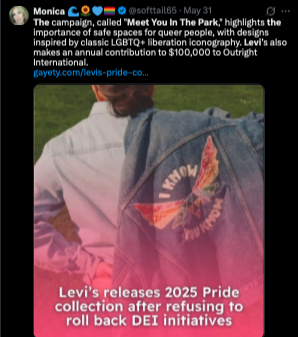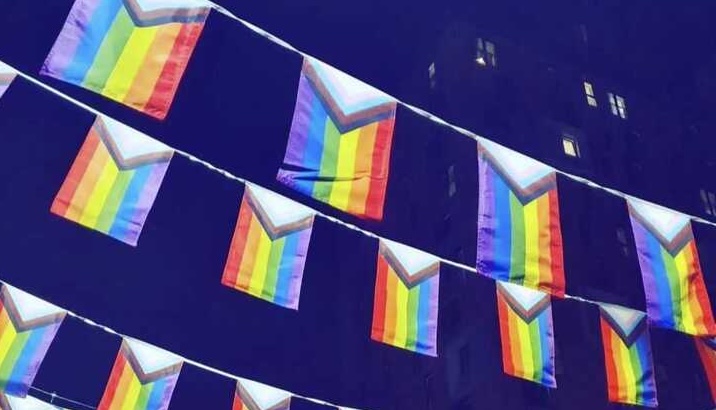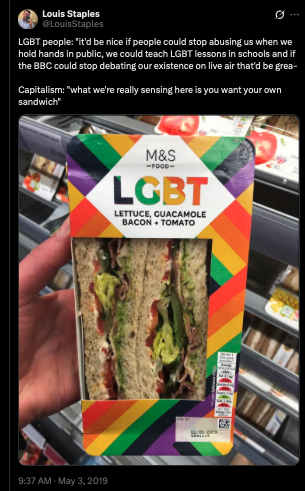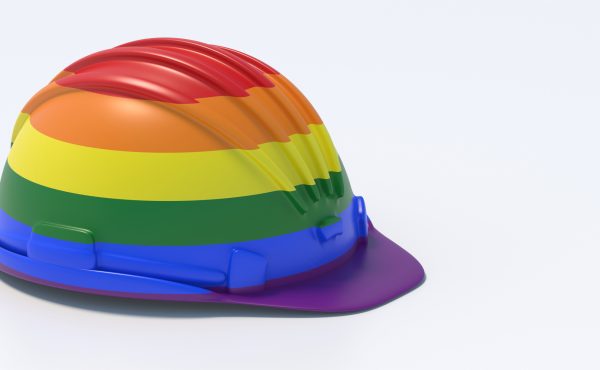Every June, we see companies change their logos to more colourful, rainbow versions or hang Pride flags in their shop windows. You might even see representatives of a company throw glitter from a branded parade float as they wave to potential customers below. But every July, those same companies return to their usual branding and fold their flags away, ready to be reused next year. In this blog, we will discuss what ‘rainbow washing’ is, how it can be avoided, and look at examples of how to deliver an effective equality, diversity, and inclusion (EDI) campaign that goes beyond Pride month.
What is rainbow washing?
Rainbow washing is when a company uses rainbows and/or Pride flags in their marketing to give the appearance of being an ally without any meaningful demonstration of LGBTQIA+ support. This is often seen to just be an attempt to capitalise on related events and consumer interest entirely for profit. Conducting this kind of surface-level marketing can result in significant backlash to a business, particularly if they are also seen to be rolling back on EDI policies and commitments.
The term ‘rainbow washing’ is coined from its predecessor, ‘whitewashing’, which originally meant the act of covering imperfections under a layer of white paint or lightening something, such as fabrics or skin. As its use changed over time, it has come to be seen as culturally and racially insensitive in that it often indicates that something negative is being glossed over to the benefit of white people. ‘Greenwashing’ also has the same roots, which is a term used to describe companies that use words like ‘sustainable’ and ‘green’ or nature images to imply that they are more eco-friendly/conscious than they really are. Whether intentional or not, this is often believed to be for commercial gain.
How to avoid rainbow washing
Using rainbow iconography and branding during Pride Month or for any other awareness campaign can be a great way to display support for the LGBTQIA+ community and demonstrate a willingness to take a stance, but it is important that this is paired with using it as an opportunity to communicate the steps that are being taken to actively advocate for the LGBTQIA+ community. Examples of this include improving internal policies, EDI commitments during recruitment, creating a support network for colleagues, purchasing from LGBTQIA+ businesses, or fundraising for related charitable organisations. The problem, however, is when a company uses Pride or any awareness day or month without being able to evidence that this is authentic support through meaningful action, demonstration of values, or a supportive internal culture.
Below is a list of tips for how you can ensure that you aren’t accidentally ‘rainbow washing’:
- By showcasing emotional intelligence (EQ)
Whether you’re looking to connect with the LGBTQIA+ community or generally work to create a more inclusive and supportive space, it’s important to be able to adequately use core competencies of emotional intelligence (EQ). Your ability to manage relationships helps to resolve conflict in addition to responding to concerns with empathy.
Also remember to do your research! Understanding the community’s history and challenges they have faced (and still do) helps you to ensure any communication has a positive influence whilst also navigating difficult subjects sensitively within any communications strategy or policy.
Being both self-aware and socially-aware strengthens your ability to be an effective ally in and outside of the business.
- By knowing what you want to say and achieve
Every successful marketing campaign will have a clear message, and this is just as important for a Pride Month or other EDI-related campaign. As we previously discussed, simply adding a rainbow to your product isn’t enough – a well-thought-out campaign with clear messaging, in addition to being able to evidence any actions you’re taking to support commitments, will make you stand out.
- By supporting relevant charities
Donating to an LGBTQIA+ charity is one way to take meaningful action to support vulnerable people within the community. Examples of LGBTQIA+ causes include chosen families, the AIDS crisis, domestic violence, human rights, refugee aid, and more. Some examples of UK-based LGBTQIA+ charities can be found here.
- By working with LGBTQIA+ businesses and creatives
Purchasing products or services from LGBTQIA+ businesses along with improving EDI policies and practices in your workplace and within recruitment processes are other ways to evidence your ethos and commitment to supporting the community.
Rainbow washing case studies
Below are two examples of companies who launched marketing campaigns and merchandise during Pride Month and whether or not they were perceived to be performative in their allyship:
The LGBT sandwich
In 2019, UK supermarket chain Marks & Spencer (M&S) launched a sandwich in honour of Pride Month. By adding guacamole to their usual BLT, the sandwich was branded the ‘LGBT’. Presented on shelves in rainbow packaging, what was intended to be a light-hearted but earnest show of support resulted in a PR disaster for the longstanding British retailer.
Why was this campaign unsuccessful?
The campaign failed to demonstrate the four key points for avoiding rainbow washing:
- It showed little sign of EQ. There was fun, rainbow packaging, with a commitment to donate to charity, but some felt this was a tokenistic twist on the BLT which reduced a historically marginalised community into a gimmick. The sandwich managed to spark outrage amongst some customers who felt M&S were instead exploiting LGBTQIA+ culture for their own commercial gain. Nick Levine wrote in an article for Vice: “if you’re a big brand creating a Pride burger, T-shirt or face cream, knowing full well that it’s going to bring you some lovely free publicity, you absolutely have to be donating all profits from that item to an LGBTQ+ charity”. This negative sentiment perhaps could have been avoided had there been a more concerted effort to communicate publicly the company’s EDI commitments, involvement within the community throughout the year, and exactly what percentage or figure of the profits would be donated. Unfortunately, much of this information is difficult to find or rarely shared so it doesn’t always feel genuine, if it was released at all. It also appears that there has been a noticeable decline since 2020 of mentions of the LGBT+ network in reports and PR. In 2025, they also received significant criticism from the organisation ‘Stop Funding Hate’ for contradicting themselves and their claims to be an inclusive company by also advertising with the controversial TV and radio station, GB News, which had made negative comments about the LGBTQIA+ community. During Pride Month, Stop Funding Hate released a post noting that there was still no public statement on this though no ads had been seen since 7 March 2025. These could have been opportunities for M&S to publicly reiterate its position and what measures they’re taking throughout the year, not just during Pride. On this occasion, they would receive further criticism for appearing to not put LGBTQIA+ people before profits which compounds the accusation of rainbow washing.
- M&S’ marketing messaging appeared to miss the mark for some. Much of the criticism around the campaign has been that it felt like an empty gesture. They appeared to fail to highlight key issues within the community and the company’s dedication to supporting those impacted by them. The sandwich became an example of what a company should think carefully about when trying to present any kind of awareness campaign around products or services they will also benefit monetarily from. There is a thin line companies walk between genuine support and commercial interest so as to avoid performative displays of allyship. What is interesting is that M&S has been visibly present during Pride since 2015 and the company’s Pride campaign talks about supporting related causes and creating a network where colleagues can feel safe and supported during Prideand beyond which are positive actions, especially when combined with the EDI commitments. What’s unfortunate is that the marketing messaging didn’t land so well with the audience, despite what we hope was the best of intentions.
- Whilst M&S’ Pride campaign aimed to support a relevant charity, many people appeared to be unaware of this or what percentage of profits would be donated. In addition, the audience also didn’t know of the internal culture or availability of support networks that had been created by and for colleagues throughout the year. It was reported later that approximately £21,000 was donated to the Albert Kennedy Trust (AKT), a charity dedicated to helping homeless LGBT+ youth, and Belong Youth Services, a similar charity operating in Ireland. It’s difficult to make any guarantees about how an audience will receive any marketing campaign, but it’s possible that the company may not have faced such intense backlash if they had been transparent on the packaging and within descriptions if a significant percentage (or all) of the profits from Pride merchandise and sandwiches would be going to LGBT+ causes. In recent years, it appears that M&S has opted for minimal publicity around LGBTQI+ events but still continued to commit to a specific donation amount around sales (£20,000 to AKT and €1000 to Belong), rather than a percentage, in addition to donation matching customer contributions via a Sparks partnership. They included a Pride landing page on the website with a little bit of information on the LGBT+ network and the Sparks partnership but only made one Instagram post on this which didn’t include hashtags and seems to have comments hidden. Comments may have been hidden to protect the community, but it’s also possible that the negative feedback around the way they have positioned these campaigns in the past may have made them nervous about having those comments public.
- With regards to connections with the community or working with LGBTQIA+ businesses, M&S has historically published EDI information and promoted its colleague-led LGBT+ network, in addition to sharing Pride stories on the M&S Careers website, but this hasn’t been communicated particularly effectively more broadly, so the consumers were likely unaware of these.
Meet you in the park 
Levi’s ‘Meet you in the park’ campaign for Pride 2025 is an excellent example of how to deliver an effective and successful Pride campaign. The premise was that the park is a safe space for LGBTQIA+ people to gather, away from their homes, schools, and other places where they may feel like an outsider. The collection echoed the campaign’s messaging of creating safe spaces for the queer community, featuring subtle designs like a denim jacket with the motif ‘I know you know’, and a cream-coloured bandana with writing such as ‘take care of each other’ and ‘our diversity is our strength’.
Why was this campaign successful?
The campaign demonstrated the four key points to a successful Pride campaign that avoided rainbow washing:
- It showcased emotional intelligence, honouring the historic struggles of the community by refusing to roll back EDI commitments and continuing to find ways to support the community. They produced merchandise inspired by LGBTQIA+ liberation, such as featuring the “inverted pink triangle, a Nazi-era symbol that was sewn onto the sleeves of gay detainees in concentration camps, and was later reclaimed by the LGBTQ+ community” as a symbol of resistance. In addition to visibility in its merchandise and through events, they have a strong history of advocating for LGBTQIA+ rights through their employee association and public support of equality and non-discrimination as a core value of their workplace. In 2020, they also set up Unlabeled, an LGBTQIA+ Employee Resource Group, to help create a strong, supportive community where people can feel safe. This demonstrates that this wasn’t a publicity stunt for a short period or event, as the 2019 Attitude article by Will Stroude noted, it appears ‘Levi’s LGBTQ allyship is year-round – not just for Pride month’.
- It knew what it wanted to say and achieve. Levi’s wanted to show their allyship and awareness of current struggles within the community. By featuring subtle designs that made impactful statements, it communicated the current political issues LGBTQIA+ people are facing, particularly in the US, and how the community may not feel comfortable loudly declaring their sexuality over fear for their safety and persecution.
- It supported a relevant charity. To support the campaign, Levi’s donated $100k to Outright International, a charity dedicated to confronting hate and intolerance against the LGBTQIA+ community, and has done so annually since 2022. The donation holds weight as it is not dependent on clothing sales, and the same amount is donated regardless of profit for the company.
- The collection was crafted by designers who identify as part of the LGBTQIA+ community. They also consulted independent external bodies and the GLBT Historical Society to ensure the community felt represented.
Pride Month is more than a marketing opportunity. It is a call to action for brands to stand in true solidarity with the LGBTQIA+ community. Companies should demonstrate these actions all year round to support the community, both internally within their organisation and externally, with charitable partnerships and community activism. Consumers expect more than rainbow coloured packaging; they expect authenticity, accountability and genuine connection. By demonstrating EQ, aligning with relevant charities, and delivering clear, purposeful messaging, brands can deliver EDI campaigns that are not only respectful and inclusive to support those inside and outside of the business, but that they also help to effectively communicate the ethos and values held by the company.
If you’re looking for support in developing a successful PR and marketing strategy for your built environment business, we can help. Get in touch to arrange a no-obligation discussion with our team.




